NSW, Queensland, WA fire emergency: Catastrophic regions extend south of Sydney
The NSW Rural Fire Service has extended warnings to include regions south of Sydney.

- Catastrophic rating explained
- Catastrophic areas extend south
- Smoke grounds water bombing
- What’s behind catastrophic rating
- List of schools closed
- NSW in state of emergency
- ‘People need help not greenies’
- Sydney urban fringes at risk
Welcome to The Australian’s Monday, November 11 live coverage of the bushfires ravaging NSW and Queensland. Live coverage for Tuesday, November 12 can be found here.
READ MORE: Darker days ahead, PM warns | Firestorms threaten to widen path of disaster | Volunteer gave his all, lost everything | Sydney in ‘catastrophic’ danger for first time | Five hours fighting a wall of flame | Insurers to prioritise fire claims |
11.16pm: Some good news from the fire front in WA...
The bushfire that was threatening lives and properties in Rockingham, Western Australia has been extinguished.
The Country Fire Service had issued an emergency warning urging people to either leave or actively defend their properties.
The alert level has been downgraded as the fire is now under control. The fire started near the intersection of Patterson Road and Charles Street in East Rockingham.
10.05pm: Where tomorrow’s fires will spread
The NSW RFS has tweeted a map where fires on the north coast are likely to spread on Tuesday.
Based on the latest forecast, we have mapped where fires on the north coast are likely to spread during tomorrow's dangerous weather. The red shows the predicted spread of fire. Check https://t.co/NXTTCbYtYQ for detailed information, advice and maps. #nswrfs #nswfires pic.twitter.com/gVstnWDrxC
— NSW RFS (@NSWRFS) November 11, 2019
8.50pm: WA bushfire approaches southwest of Perth
A bushfire is threatening lives and properties on Western Australia’s city of Rockingham.
The Country Fire Service has issued an emergency warning urging people to either leave or actively defend their properties.
The fire started near the intersection of Patterson road and Charles Street in East Rockingham.
Jamie Walker 6.16pm: Residents told to stay inside
More than three million people in Brisbane, the Gold Coast and Ipswich have been told to stay indoors as bushfire smoke wreathed the southeast Queensland population hubs, creating an “unprecedented” health hazard.
The state’s Chief Health Officer, Jeannette Young, said people should consider the consequences of being outside after air quality dipped to potentially harmful levels.
4.08pm: Is your school closing?
Check our interactive list below of NSW school closures due to bushfire risk on Tuesday.
Kieran Gair 3.05pm: Victoria lends a hand
Victoria’s Country Fire Authority has sent more than 300 of its personnel to NSW after the fire-ravaged state requested more help.
The New South Wales Premier Gladys Berejiklian has declared a state of emergency after authorities said the coming days could be the most dangerous bushfire period in the nation’s history.
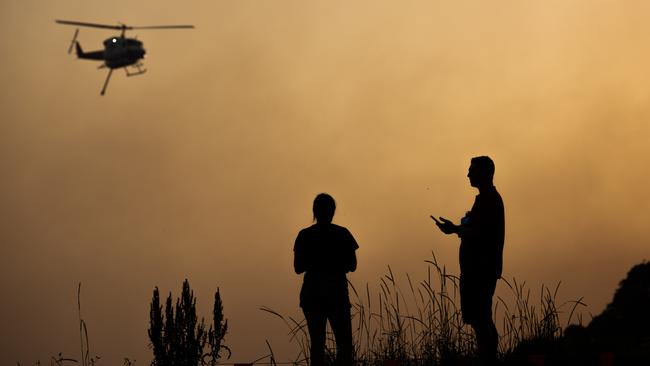
The CFA has agreed to send 286 firefighters, 18 supporting resources, six additional taskforce members and one CFA liaison officer to be positioned in the Hunter region and Goulburn.
It’s in addition to the 11 strike teams sent yesterday afternoon, which will be in position by 7pm ahead of the catastrophic fire weather conditions forecast for tomorrow.
The CFA has also dispatched a fleet of 76 vehicles, including 55 tankers and 21 operational support vehicles.
It comes after Tasmania’s Fire Service sent 27 firefighters to NSW on Sunday, including 25 volunteers.
Tasmania Fire Service acting deputy chief officer Shane Batt said the firefighters were deployed to the Northern Tablelands and the Clarence Valley regions.
2.50pm: Twenty firefighters injured
Doctors and paramedics on the ground have treated more than 100 people hurt during devastating bushfires in NSW, including 20 firefighters. NSW on Tuesday declared a state of emergency for seven days, with the danger considered “catastrophic” for the Greater Sydney, Hunter and Illawarra/Shoalhaven regions, and “severe and extreme” across large tracts of the rest of the state.
NSW Ambulance Commissioner Dominic Morgan is considering bringing in extra resources from interstate.

“Over the last few days our doctors and paramedics have been exceedingly busy - they’ve treated over 100 patients for fire-related activity,” he told reporters in Sydney on Monday.
“We had a whole range of things that have been confirmed from very severe burns, sadly resulting in a loss of life in some instances, right down to minor injuries and minor burns.” Mr Morgan paid tribute to firefighters injured in the line of duty. “That’s something that we should all be recognising,” he said. “Up to 20 (of the people treated) have been directly related to firefighters being injured while protecting their own communities.” Mr Morgan said 30 additional ambulance crews would be deployed across the state to ensure additional protection as well as extra air assets. NSW Health warned people in Sydney and the Hunter to take precautions with smoke blowing south from fires on the state’s mid-north coast forecast to cause poor air quality on Monday afternoon.
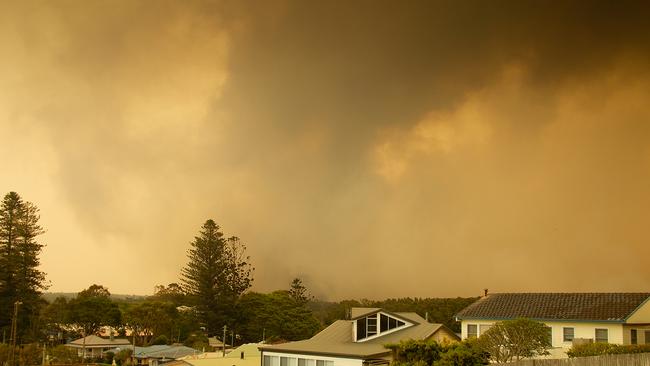
The best way to reduce smoke exposure is to stay inside with the doors and windows shut, the department’s Director of Environmental Health Dr Richard Broome said.
“For most people, smoke causes mild symptoms like sore eyes, nose and throat,” Dr Broome said in a statement on Monday.
“However people with existing lung and heart conditions like asthma, emphysema and angina are more likely to be sensitive to the effects of smoke.” “People with these conditions should avoid outdoor physical activity when there’s smoke around.”
AAP
2.36pm: Catastrophic rating explained
Greater Sydney, Hunter and Illawarra/Shoalhaven residents are bracing for “off the scale” fire danger on Tuesday.
What does the rating mean?
• The fire danger for Tuesday has been rated “catastrophic”.
• “It’s where people die”, says NSW RFS Commissioner Shane Fitzsimmons.
• Residents are being warned fires under these conditions are hard to suppress and homes will burn.
• People are being told to leave for their survival now.
• This is the first catastrophic declaration for Sydney since a new rating system came into effect 10 years ago.
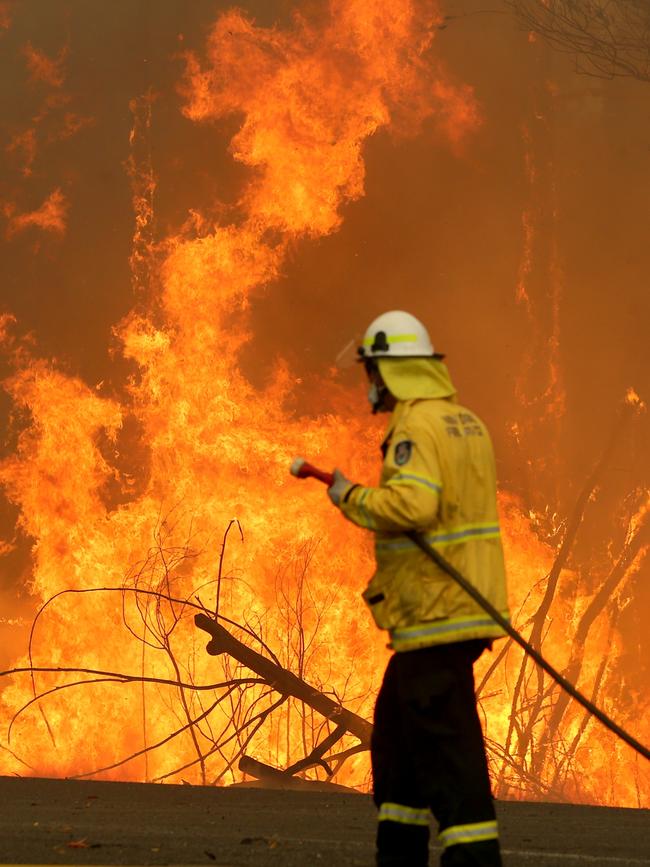
Which areas are affected?
Greater Sydney: 35 local government areas running from beachside suburbs like Manly to the Blue Mountains in the west. The danger areas are listed below.
• Sydney West and Inner West: Burwood, Camden, Canada Bay, Strathfield, Blacktown, Campbelltown, Canterbury-Bankstown, Cumberland, Fairfield, Liverpool, Parramatta Penrith, Sydney (includes some inner west suburbs).
• Sydney East: Randwick, Sydney, Waverley, Woollahra.
• North and North West: Central Coast, The Hills, Hawkesbury, Hunters Hill, Ku-ring-gai, Lane Cove, Mosman, North Sydney, Northern Beaches, Ryde, Willoughby.
South and South West: Georges River, Kogarah, Sutherland.
• The Hunter: Cessnock, Dungog, Lake Macquarie, Singleton and the Upper Hunter. * The Illawarra and Shoalhaven areas south of Sydney.
How dangerous will it be?
Australia’s worst bushfire tragedy was the Black Saturday fires of February 2009, which killed 173 people and destroyed thousands of homes. It would have carried a catastrophic rating under the present system.
AAP
Olivia Caisley 1.20pm: Catastrophic regions widened
The NSW Rural Fire Service has upgraded the fire danger for Tuesday, saying it is now expected to be worse than originally forecast. The regions rated catastrophic have been extended to include the Illawarra/Shoalhaven regions.
The fire danger tomorrow is now expected to be worse than originally forecast. The Illawarra/Shoalhaven is now forecast to experience a Catastrophic fire danger, as will Greater Sydney and Greater Hunter. More info here: https://t.co/RQyA5UAi8x #nswrfs #nswfires pic.twitter.com/1xlwByvpMz
— NSW RFS (@NSWRFS) November 11, 2019
1.15pm: BoM’s fire weather lesson
With the catastrophic fires arriving months earlier than usual, the Bureau of Meteorology has put out a video explaining fire weather: why fires occur out of peak season and how wild fires can cause their own storms that exacerbate the fire danger.
Dangerous #fire weather conditions continuing for large parts of Aus today, with eastern #NSW & #SEQ becoming the focus again from Tuesday.
— Bureau of Meteorology, Australia (@BOM_au) November 11, 2019
Learn more about fire weather in our video. For latest weather warnings see https://t.co/KipaPVCPve; follow advice from emergency services pic.twitter.com/6vkBkmNo19
1.05pm: Vic releases shocking safety video
The Victorian State government has released a confronting video to snap Australians out of complacency toward the dangers of bushfires.
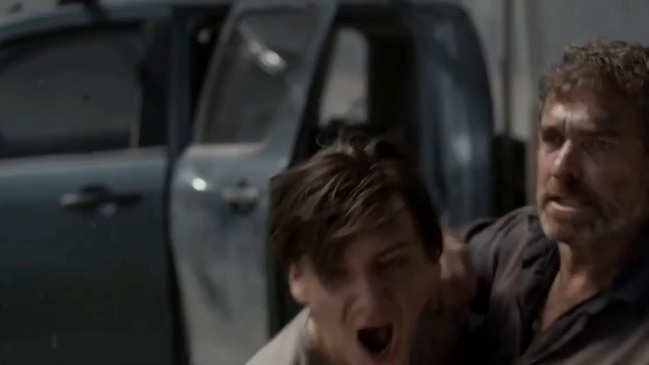
Premier Daniel Andrews introduced the new ads to the public on Sunday but warned “many people will be shocked” by what they see and hear.
The hard hitting video, titled ‘Know your Fire’ show people trapped by the flames as they try to escape, and in deep distress having to leave pets behind.
The video, part of this year’s bushfire survival and safety campaign, features survivors of the Black Saturday bushfires which claimed the lives of 180 people in 2009. It is set to run across TV, print, radio and digital media.
12.50pm: Sydney councils rated Catastrophic
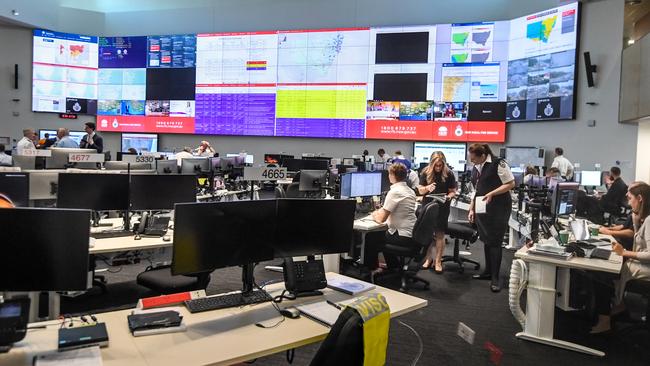
The NSW RFS has listed the Sydney councils that will be affected by the Catastrophic rating on Tuesday. They are:
The Hills, Blacktown, Blue Mountains, Burwood, Camden, Campbelltown, Canada Bay, Fairfield, Hawkesbury, Hornsby, Hunters Hill, Kogarah, Ku-ring-gai, Lane Cove, Liverpool, Mosman, North Sydney, Parramatta, Penrith, Randwick, Ryde, Strathfield, Sutherland, Sydney, Waverley, Willoughby, Woollahra, Bayside, Canterbury-Bankstown, Central Coast, Cumberland, Georges River, Inner West, Northern Beaches.
12.05pm: What does ‘Catastrophic’ mean?
The rating of ‘Catastrophic,’ in place since the 2009 Black Saturday fires in Victoria, is the highest possible fire rating. For homeowners, it means there is no ‘stay and defend’ option, because no homes are built to withstand fire conditions this extreme.
NSW will experience very dangerous fire conditions tomorrow, with Catastrophic fire danger forecast for Greater Sydney and Greater Hunter. Lives and homes will be at risk. A Total Fire Ban is in place for the all of NSW. More info here: https://t.co/6Rk3vcj6uv#nswrfs #nswfires pic.twitter.com/CfqNsxKJLs
— NSW RFS (@NSWRFS) November 11, 2019
According to the RFS, a rating of ‘Severe’ means only stay if your home is well prepared and you’re ready to defend it.
At ‘Extreme,’ a homeowner should only stay if their home is prepared at the highest level and is specially built to withstand a fire.
At ‘Catastrophic,’ the homeowner has no safe option but to leave before a fire starts.
We are entering an extremely dangerous period of fire danger across NSW - because of the large amount of fires already burning, and increased fire danger ratings. Know the fire danger and what you will do, especially if you're in an area of Catastrophic fire danger. #nswrfs pic.twitter.com/Dm6o23BV5U
— NSW RFS (@NSWRFS) November 10, 2019
11.30am: CFUs banned from acting
Community Fire Units - local residents who help prepare their neighbourhood for bushfires - have been banned from acting by the RFS because of the catastrophic fire rating.
CFU members were texted on Tuesday and told: “CFUs aren’t permitted to activate. Prepare your homes and plan to leave early.”
This is what 'Watch and Act' looks like. #lunatic #bushfires #auspol pic.twitter.com/J0FlJVg61z
— Dr Di Rayson (@dianne_rayson) November 11, 2019
Kieran Gair 11.05am: Brisbane air quality among worst
Air quality in Brisbane is among the worst in the world as dense smoke blankets the city and large swathes of south-east Queensland.
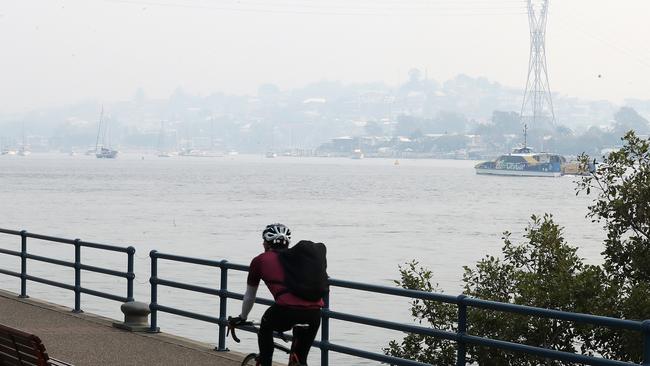
Brisbane’s air quality is currently rated as ‘very unhealthy’ by The World Air Pollution Quality Index.
The Bureau of Meteorology said smoke from the NSW fires has been pushed out to sea by a south-westerly wind and a light south-easterly has blown it back onto south-east Queensland.
Brisbane’s air quality is today only on par with parts of India, Turkey and one smog-choked location in Vietnam and California.
Kieran Gair 11.00am: Smoke grounds water bombing
Authorities have been forced to temporarily call off a crucial aerial water-bombing mission near Yeppoon after thick smoke compromised visibility and made it impossible for pilots to effectively target the worst-hit spots.
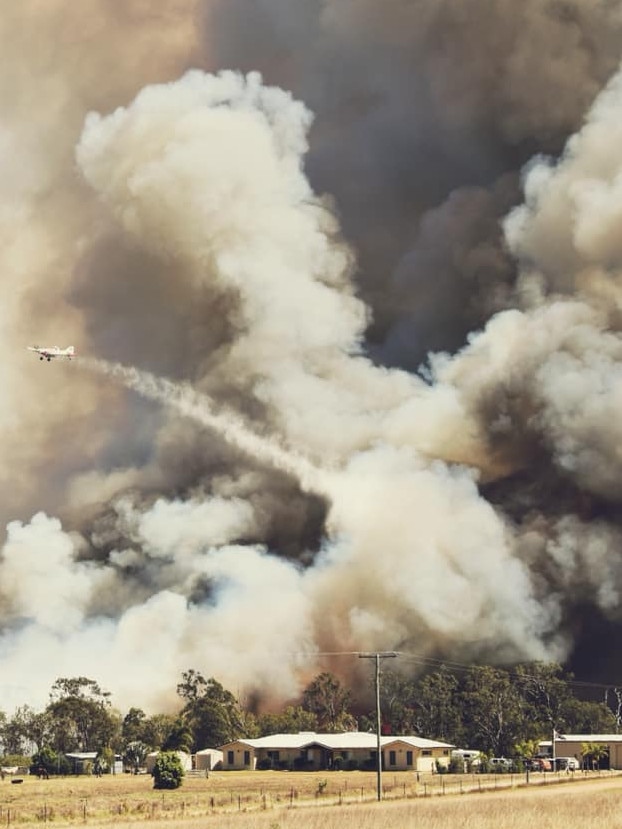
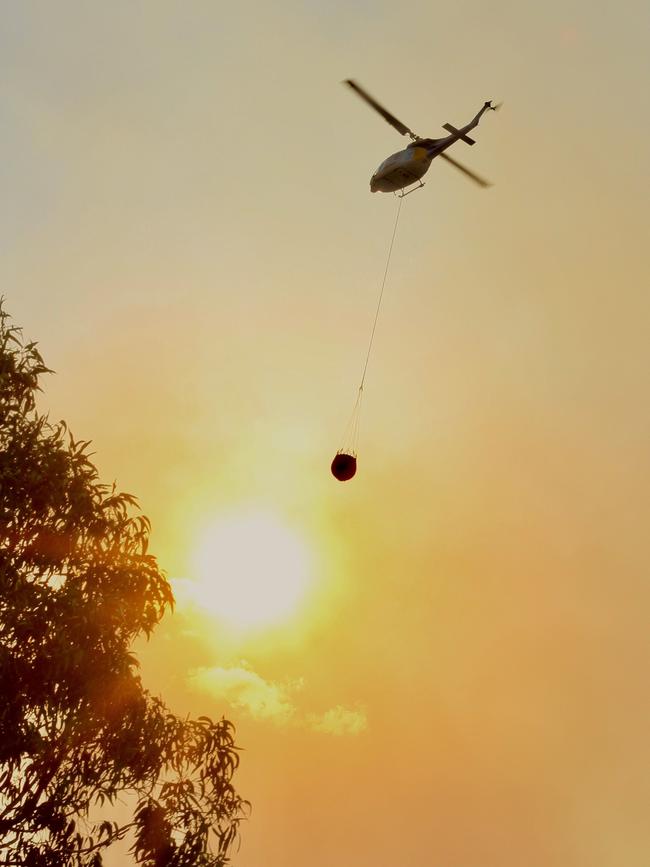
Emergency services said pilots will resume the water-bombing campaign as soon as visibility returns, but for the time being dense smoke has rendered the air attack futile.
The blaze is part of the Cobraball-Bungundarra fire and is burning near Bungundarra, Maryvale and Lake Mary.
At its height, the fire near Yeppoon was 14 kilometres long and six kilometres wide and burning on multiple fronts.
More than 30 people sheltered in a basketball stadium in Yeppoon on Sunday night.
The Cobraball fire is currently at a ‘watch and act’ level and residents are being told to prepare to leave if conditions worsen.
10.35am: What’s behind catastrophic rating
A combination of hot, dry and windy weather with high fuel loads is behind the catastrophic fire rating for swathes of NSW on Tuesday, including Sydney and the Blue Mountains.
A wave of hot, dry and windy weather will elevate fire danger ratings across multiple states and territories during the next three days: https://t.co/R3bsj64pgR pic.twitter.com/OaS6sErG4e
— Weatherzone (@weatherzone) November 10, 2019
According to the Weatherzone website, a mass of hot dry air currently over south Australia will move further north and east into NSW and southern Queensland on Tuesday, with temperatures forecast to reach over 40 in some areas.

Sydney is forecast to reach a top of 37 degrees before a blustery cool change arrives in the city on Tuesday evening.
Tuesday’s heat in NSW will combine with low relative humidity and strong winds, causing widespread Severe and Extreme fire danger ratings across most of the state. The most intense combination of heat, wind, low humidity and dry fuel loads - due to less burning off than usual - will occur in the Greater Sydney and Greater Hunter districts, with these densely populated districts rated Catastrophic.
With dangerous fire weather forecast this week, you need to plan. If you need help making one check https://t.co/EkQp8gBNbG #nswrfs #nswfires
— NSW RFS (@NSWRFS) November 10, 2019
Olivia Caisley 10.15am: Fire risk ‘off the scale’
NSW Rural Fire Service Commissioner Shane Fitzsimmons has stressed the gravity of the “catastrophic” conditions declared for the Sydney and Hunter regions on Tuesday.
“Catastrophic is off the conventional scale,” Mr Fitzsimmons said on Monday. “We are talking about indices that go well beyond the old scale of 100.”
The blazes are raging from the northern border with Queensland down to the mid-north coast, out to the state’s central west and south toward the Illawarra.
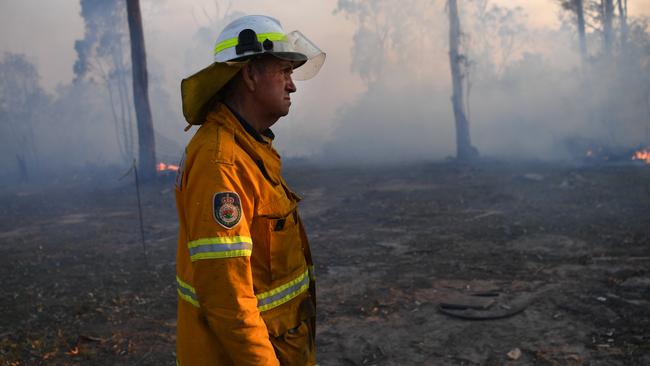
“Whilst it’s unprecedented to have catastrophic here in Sydney, we have had catastrophic across New South Wales over the last decade since the new program came into effect in 2009,” Mr Fitzsimmons said. “But I am confident in my memory that even when we were looking at rebranding the fire danger rating system to include catastrophic at the top, even when we were looking at the indices that drove that new branding of catastrophic, we could not find a time in history under the old metrics where we saw indices reaching what we now know are catastrophic levels here in the Greater Sydney environment.”
“We are talking about something we haven’t experienced before in Sydney in the Greater Sydney environment, albeit we have seen it across parts of New South Wales.”
Bushfires near Taree #Australia #bushfires #bushfireNSW #NSW pic.twitter.com/0UVPgKWDa8
— Pleun (@xopleun) November 10, 2019
10.12am: Schools closed Nov 11, 12: List
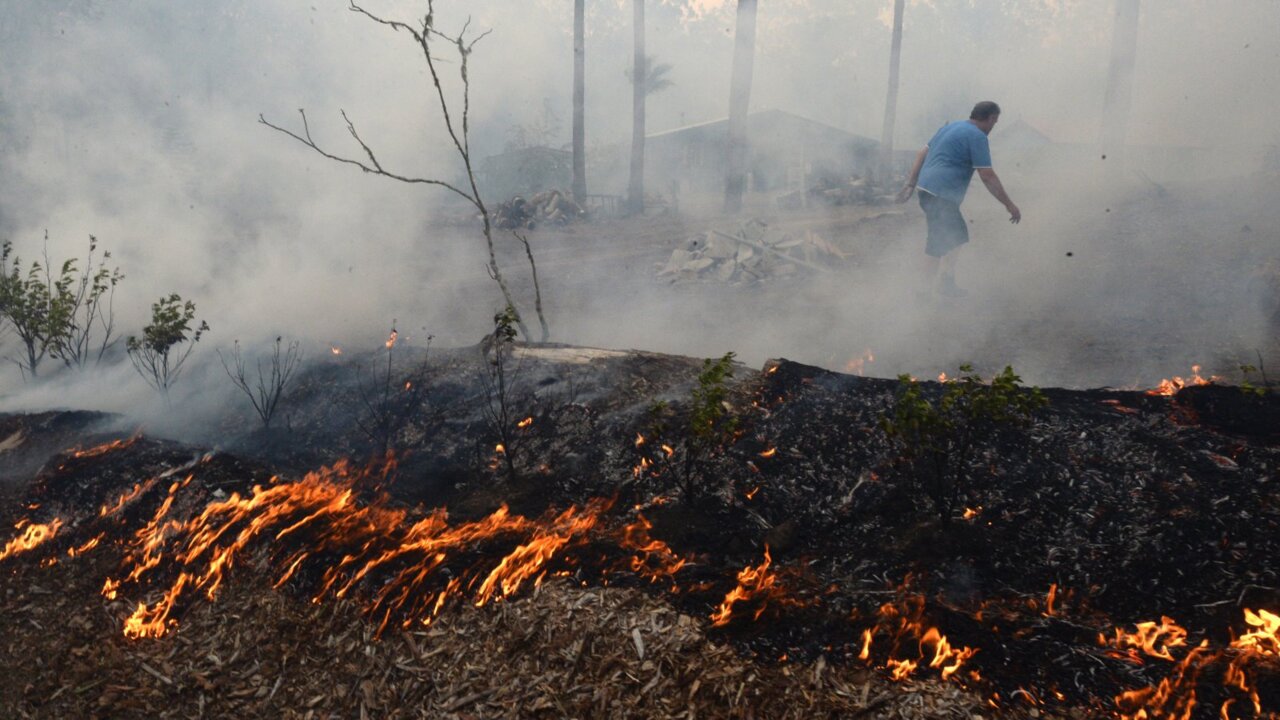
• Alesco Senior College (Coast campus)
• Barkers Vale Public School
• Baryulgil Public School
• Beechwood Public School
• Bellbrook Public School
• Ben Lomond Public School
• Bobin Public School
• Cascade Environmental Education Centre
• The Channon Public School
• Coffee Camp Public School
• Coolongolook Public School
• Coopernook Public School
• Coutts Crossing Public School
• Deepwater Public School
• Dundurrabin Public School
• Elands Public School
• Emmaville Central School
• Glenreagh Public School
• Hallidays Point Public School
• Hannam Vale Public School
• Harrington Public School
• Heron’s Creek Public School
• Huntington Public School
• Johns River Public School
• Krambach Public School
• Lansdowne Public School
• Long Flat Public School
• Lowanna Public School
• Manning Gardens Public School
• Manning River Anglican School
• Medlow Public School
• Mingoola Public School
• Mitchells Island Public School
• Moorland Public School
• Mount George Public School
• Nabiac Public School
• Nana Glen Public School
• Nimbin Central School
• The Nature School
• Nymboida Public School
• Old Bar Public School
• Oxley Island Public School
• Pacific Palms Public School
• Port Macquarie Steiner School
• Rainbow Ridge for Steiner Education
• Rollands Plains Upper Public School
• Taree Christian School
• Telegraph Point Public School
• Tinonee Public School
• Tuntable Creek Public School
• Tuntable Falls Community College
• Ulong Public School
• Upper Coopers Creek Public School
• Upper Lansdowne Public School
• Whian Whian Public School
• Willawarrin Public School
• Wingham Brush Public School
• Wingham Public School
• Wytaliba Public School
• Yarrowitch Public School
The Catholic Education Diocese of Parramatta announced a total of 16 schools would be closed following assessments by RFS volunteers of schools being most at risk from bushfires. The Catholic Education Diocese of Parramatta announced a total of 16 schools would be closed following assessments by RFS volunteers of schools being most at risk from bushfires.
• St Michael’s Primary School, Blacktown South
• Catholic Out Of School Hours Care, Blacktown South
• Catholic Education Early Learning Centre Mary Queen of the Family Parish, Blacktown South
• Nagle College, Blacktown South
• Corpus Christi Primary School, Cranebrook
• McCarthy Catholic College, Emu Plains
• St Finbar’s Primary School, Glenbrook
• Catholic Out of School Hours Care St Finbar’s, Glenbrook
• Holy Family Primary School, Luddenham
• St Canice’s Primary School, Katoomba
• St Madeleine’s Primary School, Kenthurst
• Marian Catholic College, Kenthurst
• Our Lady of the Nativity Primary School, Lawson
• Xavier College, Llandilo
• St Thomas Aquinas Primary School, Springwood
• St Columba’s Catholic College, Springwood
Steve Jackson 9.40am: Backburn delay worsens conditions
A delay in scheduled back-burns in the lead up to the summer bushfire season has exacerbated conditions as the residents of Great Sydney and its surrounds brace themselves for “catastrophic” fire condition on Tuesday.
As of Monday morning, fire crews were battling 64 separate blazes in NSW, of which some 40 were still uncontained.

While it is understood some members of the RFS have complained in recent weeks that “green tape” had restricted their ability to perform controlled back-burns and reduce the risk of bushfires, the RFS denied there had been any political interference.
“There have been delays with controlled fires but that has been the result of the weather and not any red tape or green tape, or whatever you want to call it,” a spokesman today The Australian on Monday.
“A series of wind patterns meant we could not perform some controlled burns without the smoke drifting over Greater Sydney and we always keep the health of nearby residents in mind when conducting them. And the early onset of the bushfire season this year has been another major factor.”
With extreme and severe warnings in place across large swathes of NSW, the spokesman urged all residents in affected regional to plan ahead.
“It’s not just the people in the first row of houses in these regions who need to prepare,” he said.
9.10am: NSW in state of emergency
NSW Premier Gladys Berejiklian has declared a state of emergency for seven days as Sydney, the Blue Mountains, the Hunter and the Central Coast regions face catastrophic fire danger.
Click here to see the RFS Fires Near Me map
Emergency Services Minister David Elliott said residents were facing what “could be the most dangerous bushfire week this nation has ever seen”.
Ms Berejiklian said the last time a state of emergency was declared in the state was 2013 when there were extensive bushfires in the Blue Mountains.
NSW Premier @GladysB has declared a state of emergency due to dangerous fire risk and forecast conditions. The state of emergency will remain in place for seven days. #nswrfs #nswfires pic.twitter.com/KxReFn9pGP
— NSW RFS (@NSWRFS) November 10, 2019
Olivia Caisley 9.05am: ‘No doubt’ drought factor in fires
NSW Premier Gladys Berejiklian has said there is “no doubt” drought conditions have contributed to ferocious bushfires in Queensland and NSW, but has cautioned against getting into a “political argument” about whether climate change is to blame.
“There is no doubt the deep drought that contributed to the conditions we are seeing but I certainly don’t think it’s appropriate to get into a political argument into what the causes are,” Ms Berejiklian told ABC News Breakfast on Monday.
“There’s no doubt we are seeing hotter temperatures, longer summers, more extreme weather conditions, but our first and foremost priority is to keep people alive at this stage, keep properties safe and to contain the fires.”
She said fire commissioners were gathering all the intelligence they could to prepare themselves for predicted “catastrophic” conditions on Tuesday, as well as into the future.
“We are gathering all the intelligence we can to prepare ourselves for what’s coming up not just this week but in the next months and years because unfortunately this is a phenomenon that appears to be ongoing here.”
Kieran Gair 9.00am: Wong - focus on fires, not point scoring
Labor frontbencher Penny Wong has weighed into the war of words between The Nationals and The Greens over the link between climate change and the current bushfire crisis gripping NSW and Queensland.

Senator Wong has urged the feuding parties to dial down the heated rhetoric and instead engage in a more sensible discussion about bushfire preparedness and climate change.
“When we get through this, it is a responsible thing for us to focus on how we plan to keep Australians safe,” Ms Wong said on Monday.
“I’m a former climate minister … Warnings about a longer bushfire season and more intense fires have been on the table for a long time.”
Deputy Prime Minister and Nationals leader, Michael McCormack, has accused The Greens of trying to score political points by linking the bushfires to climate change.
But Senator Wong said right now the focus needs to be on the affected communities and a debate about the cause of the bushfires can come once the immediate threat eases.
Kieran Gair 8.55am: Blue Mountains braced for mass evacuation
The state MP for the Blue Mountains said the region’s evacuation centres are bracing for an influx of residents ahead of Tuesday’s catastrophic fire danger.
Trish Doyle said the unprecedented threat posed to the community will spark a “mass exodus” of residents from the region.
“I would say there will be a mass exodus today from the mountains, people heading down onto the plains or along to the coastlines to spend time with friends and family,” Ms Doyle told ABC Radio Sydney.
“There is that degree of anxiety about what one should do, so if you’re not sure, go and go early.”
Trish Doyle also warned her constituents that already-stretched fire crews won’t be able to protect all of the region’s properties.
Olivia Caisley 8.15am: ‘People need help, not woke greenies’
Deputy Prime Minister Michael McCormack has lashed the “disgraceful, disgusting” behaviour of “raving inner city lunatics” for linking climate change to the ferocious bushfires burning across Queensland and NSW.
There is a total ban today and tomorrow for the whole of New South Wales. Tuesday is the big concern, Sydney will face a catastrophic fire danger for the first time. The Blue Mountains, Central Coast & Hunter regions are also facing catastrophic fire danger tomorrow. #7NEWS pic.twitter.com/jW9JAszXPS
— 7NEWS Sydney (@7NewsSydney) November 10, 2019
Firefighters across Sydney and NSW are bracing for “catastrophic” conditions on Tuesday.
“What people need now is a little bit of sympathy, understanding and real assistance, they need help, they need shelter,” Michael McCormack told ABC Radio on Monday.
“They don’t need the ravings of some pure, enlightened and woke capital city greenies at this time when they’re trying to save their homes.”
Mr McCormack said he found it “galling” when people raised climate change in relation to bushfires.
Agriculture Minister David Littleproud defended his colleague on Monday, telling ABC News Mr McCormack was trying to get results for the people who have been impacted by the fires.
“Let’s have those conversations in the cold, hard light of day after the event,” Mr Littleproud said. “But our focus and energy should be on the men and women fighting these fires and also the state, federal government and local … men and women, and children who are at risk.”
8.05am: Queensland threat eases
Queensland’s bushfire threat has eased with authorities scrambling to get on the front foot before conditions worsen again later this week.
Four homes are confirmed lost in the latest fires, the fire service and the premier have confirmed. About a dozen other structures have also been lost. Crews are continuing to fight three major fires across the state, including one that remains uncontained at Cobraball, southwest of Yeppoon in central Queensland.
Calmer conditions could help firefighters in Queensland gain the upper hand as they continue to battle more than 50 bushfires across the state.@bg_savage has the latest. pic.twitter.com/3PBJFlyXfw
— 10 News First (@10NewsFirst) November 10, 2019
Queensland Fire and Emergency Services Assistant Commissioner Megan Stiffler says three homes were lost in that fire.
The second major blaze is at Cooroibah, on the Sunshine Coast, where one home was destroyed.
The third major blaze is at Thornton in the Lockyer Valley, west of Brisbane. The Thornton State School is closed on Monday.
7.20am: Uncertainty over HSC exams
NSW Education Minister Sarah Mitchell has advised students sitting their HSC to contact their school if they are unsure if exams will occur, or if it is unsafe for them to get to an examination venue.
The NSW National Parks and Wildlife Service will also expand closures of national parks and reserves until further notice.
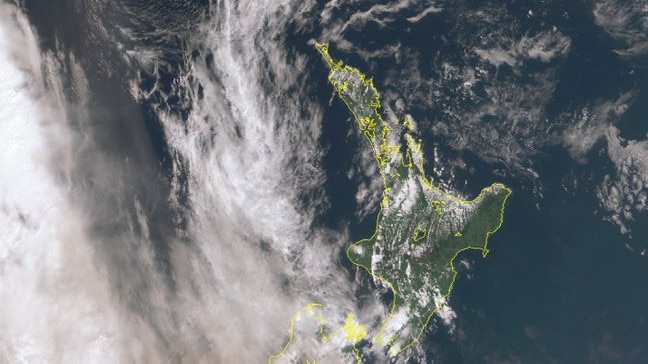
7.15am: At least 40 out of control fires in NSW
Firefighters are battling up to 64 bushfires across NSW including the fire-ravaged north coast where three people died and at least 150 homes were destroyed over the weekend.
Of those, 40 fires remain uncontained and 40 schools around the area have been closed on Monday after a total state fire ban was declared for Monday and Tuesday.
There are 64 fires burning across NSW. 40 of these fires are not yet contained. The NSW Rural Fire Service says many of these fires won't be contained before tomorrow's dangerous fire weather. https://t.co/B76SFJaejq #NSWfires #7NEWS pic.twitter.com/Z7N4EuAvpW
— 7NEWS Sydney (@7NewsSydney) November 10, 2019
Authorities have also declared a “catastrophic” fire danger for the Greater Sydney region, including the Blue Mountains and the Hunter, on Tuesday - the first time this warning level has been advised in the 10 years since new fire danger ratings were introduced.
“Catastrophic is as bad as it gets. Homes are simply not designed to withstand fire under those conditions,” RFS spokesman Anthony Clark said. “We’ve got big population centres covered by that catastrophic fire danger. “Up on the north coast, where we’ve simply got a lot of fires burning at the moment, those fires have got a real potential to run and impact on lives and properties on Tuesday.
“So the risk is very real.”
At 6am there's 64 bush and grass fires across NSW, 40 not yet contained. Many of these fires won't be contained ahead of tomorrow's dangerous fire weather. Catastrophic fire danger has been declared for Tuesday in Sydney and Hunter areas. Use today to get ready. #nswrfs pic.twitter.com/Qto5IF8PUH
— NSW RFS (@NSWRFS) November 10, 2019
6.30am: Urban fringes at risk
The RFS has warned Sydney’s urban fringe is at high risk of fire this week.
“Built-up areas where people live such as the northern suburbs of Sydney, up through the Central Coast, the Blue Mountains, the Sutherland Shire - if you’re living anywhere near the bush, you are at risk,” RFS spokesman Anthony Clark told the ABC.

“We’ve got big population centres covered by that catastrophic fire danger,” Mr Clark said.
“But also up on the north coast where we’ve simply got a lot of fires burning at the moment, those fires have got a real potential to run and impact on lives and properties on Tuesday.
“So the risk is very real.” Mr Clark said that around the Sydney area, they were “really concerned” about the urban fringe.
A statewide total fire ban has been declared for Monday and Tuesday. Large parts of the state will be subject to high and very high fire danger on Monday, and more than 40 schools will be closed.
The NSW National Parks and Wildlife Service will also expand closures of national parks and reserves until further notice
.AAP
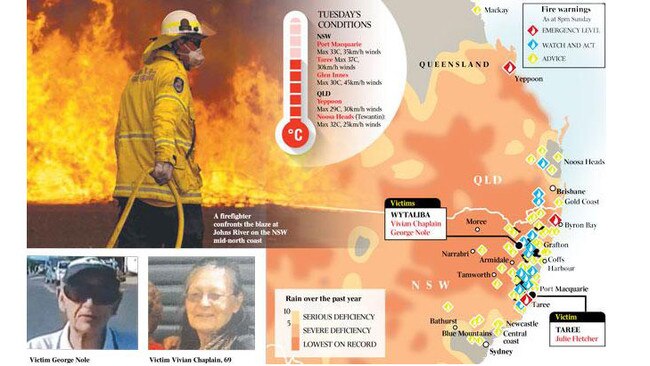
6.15am: Brief respite in Queensland
Calmer conditions may help firefighters gain the upper hand as they battle more than 50 bushfires across Queensland but dangerous winds look set to return. The most challenging blazes are at Cooroibah, north of Noosa, and Cobraball, near Yeppoon, where 17 homes have been lost and thousands of people were forced to flee.
Residents have also been told to evacuate a fire at Thornton in the Lockyer Valley.
A prepare to leave warning remains in place for blazes at Tarome and Clumber, about 80km southwest of Brisbane; Kilkivan and Jimna near Gympie; and Lower Beechmont in the Gold Coast hinterland.
Livingstone Shire Council mayor Bill Ludwig says the out of control Cobraball blaze is one of most dangerous and unpredictable fires the region had seen. “This is a fire with multiple fronts, there’s a front heading to the north, two heading to the east in different locations, and one heading to the south, and another the west,” he said.
“With no rain on the horizon, this is something to play out through the reduction of fuel loads through the fire working its way in the direction the elements are taking it.” To the south, firefighters have been able to gain the upper hand on a series of blazes that forced about 8000 people from their homes in the suburbs to the north of Noosa.



To join the conversation, please log in. Don't have an account? Register
Join the conversation, you are commenting as Logout